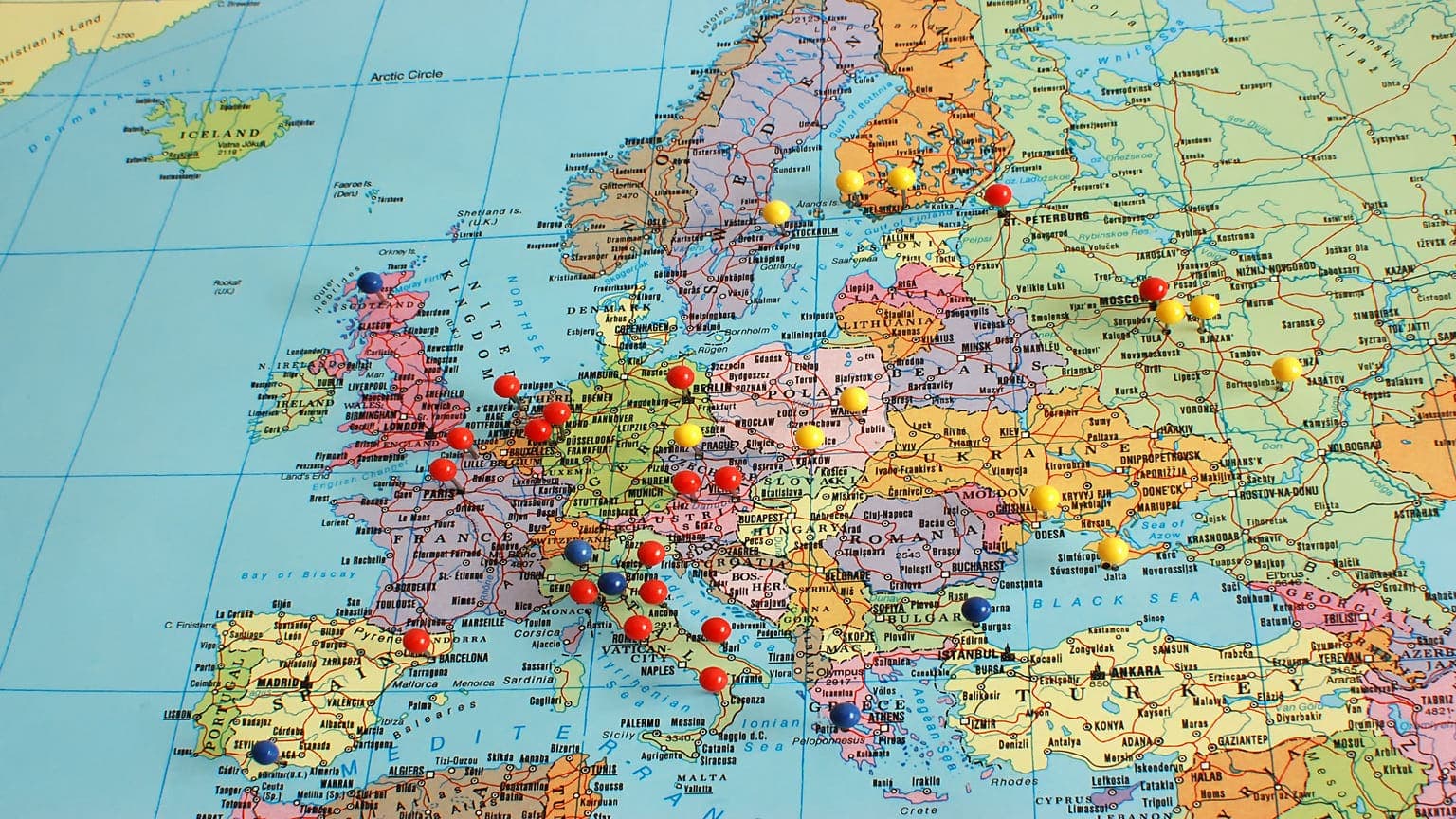

Summary
The Schengen Area is a zone that covers the majority of the European countries. Within this zone, there is no border control.
Although most of the Schengen countries also belong to the European Union, these two areas are not the same. We explain how the Schengen area differs from the EU, how it functions and which countries it includes.
The Schengen Agreement: how it all started
Presently, the Schengen Area consists of 29 countries that abolished the common borders. Many people seek to obtain a residence permit in the Schengen country to ensure freedom of movement.
The history of the Schengen Area started in 1985, when Belgium, Germany, Luxembourg, the Netherlands, and France signed an agreement allowing visa-free travel without customs control at the borders between said countries. The Schengen Agreement was named in honor of Schengen, a city located nearby in Luxembourg.
The parliaments of these five countries then discussed the details of the union for ten years before the Schengen Agreement came into force in 1995.
The Schengen Area then expanded steadily: Austria, Denmark, Finland, Iceland, Norway, and Sweden joined the Area in the 1990s. Other countries were accepted between 2000 and 2011. As of now, the last country to join the Schengen Area was Croatia: its application was accepted in 2022.
By January 2025, the Schengen Area consisted of 29 countries, which had pledged to be governed by common laws:
-
visa-free travel inside the zone;
-
common visas and common rules of entry and exit from the common area;
-
exchange of information between the police and courts of member states.
The Schengen Area and the European Union: what’s the difference
The Schengen Area and the European Union often get confused, but they operate under different frameworks. Understanding how each system functions helps avoid visa complications and makes travel or relocation smoother.
Schengen Area
The Schengen Area is a specific area consisting of 29 European countries that officially abolished all border controls at the borders they share. In addition, the Schengen Area includes Madeira, the Azores, and the Canary Islands, which are located in the Atlantic Ocean.
European Union
The European Union is an economic and political union of 27 states, which have not only abolished internal visas, but have also voluntarily transferred part of their powers to the European Parliament and the Council of the European Union.
25 countries belonging to the Schengen Area are also part of the European Union. Iceland, Liechtenstein, Norway, and Switzerland are part of the Schengen, but didn’t join the EU.
San Marino, the Vatican, Monaco and Andorra also adhere to the Schengen Agreement, even though they are not part of the Schengen Area. You can visit them on a Schengen visa, but for that, you need to enter them from another Schengen country.
There are also territories that belong to the Schengen states, but do not adhere to the Schengen agreement: Greenland, the Faroe Islands, Svalbard, Bear Island, Martinique, Mayotte, Reunion, Saint Barthélemy and Saint Martin. To enter them, you would need to apply for a visa for that specific region.
Countries that are part of both the EU and the Schengen area:
- Austria;
- Belgium;
- Bulgaria;
- Croatia;
- Czech Republic;
- Denmark;
- Estonia;
- Finland;
- France;
- Germany;
- Greece;
- Hungary;
- Italy;
- Latvia;
- Lithuania;
- Luxembourg;
- Malta;
- Netherlands;
- Poland;
- Portugal;
- Romania;
- Slovakia;
- Slovenia;
- Spain;
- Sweden.
In the EU, not in the Schengen, but Schengen visa is still valid :
- Cyprus;
- Ireland.
Part of the Schengen, but not in the EU:
- Iceland;
- Liechtenstein;
- Norway;
- Switzerland.

The Schengen Area covers the majority of Europe and consists of 29 states
How does the Schengen Area function?
There are several things that define the Schengen Area.
-
Schengen states don’t have an internal border control, but they work together to strengthen external borders. Because of that, citizens of Schengen countries can move around the area without needing to obtain a visa.
-
Foreigners traveling around the Schengen have to go through the border control only once, when first entering the area.
-
The Schengen Area has common rules that apply to non-Schengen nationals aiming to visit the area.
The Schengen Area has laws and regulations that help its states exchange information. One of them is Visa Information System (VIS), aiming to:
-
make issuance of visas and border checks easier;
-
protect travelers;
-
prevent criminal activity;
-
enhance security;
-
help process asylum applications.
Another system, the Schengen Information System (SIS), is designed for the authorities to cooperate on border control, law enforcement, and vehicle registration.
Schengen visa validity
The validity of the Schengen visa depends on many factors: to name a few, your visa history, purpose of your travel, and your nationality. The visa can be given for a period of your trip or for longer — for example, half a year.
When you receive a visa, you need to pay attention to the number of days you’re permitted to stay in the Schengen Area. This period is usually shorter than the period of visa validity. If you exceed the number of allowed days, you might get fined or even banned from the Schengen zone.

Trusted by 5000+ investors
Comparison of citizenship and residency by investment programs
Common rules: a Schengen visa and how to obtain it
A Schengen visa is a document that allows you to enter the Schengen zone. The holder of the visa doesn't need to present it when they move between the Schengen states:It is required only once, when entering the Schengen area.
For example, if Spain is the first country you’re visiting, you need to show the visa at its border. Then, if you go from Spain to France, you can just enter without needing to present the document.
There are four types of Schengen visas:
-
A: transit, valid only in the transit zone of an airport;
-
B: transit through the Schengen countries, issued for up to 5 days;
-
C: short-term, for traveling or short residing in the Schengen Area;
-
D: national, valid only in the country that gave it; issued for working, studying, or residing for a long time in a specific country.
The C visa can be obtained for:
-
a single entry — you can enter the Schengen Area only once, the moment you leave it you can’t return with the same visa;
-
double entries — you can enter and leave the Schengen zone twice;
-
multiple entries — you can enter the area as many times as you wish during the validity period of your visa.
The category C visa is the most popular one. It allows its holder to spend 90 out of 180 days in Schengen countries. For example, the one-year category C visa allows the holder to spend 90 consecutive days in the Schengen in the first half of the year, and then another 90 days in the second half of the year.
To apply for the C-type visa, the applicant must provide the following documents:
-
passport valid for another 3 months after the expiry of the visa;
-
a form including full name, contact details, purpose, and duration of the trip;
-
several photos 35x45 mm;
-
medical insurance valid in all countries that you plan to visit;
-
reservation of accommodation;
-
bank statements — the requirements on the minimum amount of money in the current account varies, each country determines it independently;
-
a return ticket or other confirmation showing that the applicant does not plan to remain in the Schengen zone illegally: for example, a marriage certificate, child’s birth certificate, or proof of property ownership.
For Schengen visas, applicants’ biometric data, including digital photographs and fingerprints, need to be resubmitted every five years.
Schengen visas are issued and picked up at the consulate or a visa center of the issuing country. When planning a tour of Schengen countries, the visa application should be made at the consulate of the country where you plan to spend the most time in.
In 2020, the rules for issuing Schengen visas were tightened. Applicants from some countries become eligible for one-year multiple-entry visas only after they have already received three short-term Schengen visas in the two preceding years.
Applicants who were granted a one-year Schengen visa in 2019—2020 will be able to apply for a two-year Schengen visa. Five-year Schengen visas will generally only be issued to those who have received a two-year Schengen visa in 2018—2020.
The period for reviewing and processing Schengen visa applications has now been extended from less than a month to 45 days. The consular fee varies depending on a number of factors, including the country of citizenship of the applicant and type of a visa.
Which countries you can visit with Schengen Visa
Future of the Schengen Area
The Schengen Area has recently experienced several crises due to the coronavirus pandemic and the Russian-Ukrainian conflict. Despite that, the area is stronger than ever: it maintains its economic, political, and social ties.
In all likelihood, the Schengen Area will continue to expand. In January 2025, Bulgaria and Romania were admitted.
The Schengen Zone also plans to implement the Entry/Exit System (EES) that is designed for non-EU nationals who plan to visit the area for a short period of time. It applies to both citizens who need a visa to enter the Schengen and those who come from the visa-exempt countries. The EES will make the process of border control easier and faster.
Candidate states for the Schengen zone accession
Cyprus and Montenegro plan to become part of the visa-free Schengen Area in the near future. The European Parliament has postponed these countries' accession to the Schengen zone several times. Cyprus was denied entry due to its conflict with Turkey.
The exact date when these countries will join the Schengen Area has not yet been decided. Nonetheless, foreign citizens can travel to Cyprus and Montenegro on a Schengen visa.

The beautiful towns in Bulgaria, such as Sozopol, are popular tourist destinations. Since 2025, Bulgaria is part of the Schengen Area
Travelling without borders: how to choose a European country for residence
Several European countries give an opportunity to obtain residence permits by investment. With this document, you are allowed to travel visa-free around the Schengen states.
The programs differ in terms of processing time, conditions, benefits, and investment amount.
Malta, Portugal, and Greece programs comparison
Malta
Malta offers an investment program that allows a foreign citizen to obtain a residence permit. The residence permit gives the holder a right to spend 90 consecutive days in the Schengen Area and the European Union.
Investors with confirmed capital of €500,000 are eligible to obtain permanent residence in Malta. A permanent residence permit is issued in 6 months. The minimum investment is €169,000.

Demand for Maltese real estate has been supported by foreigners interested in residence by investment as it requires to rent or acquire real estate
Portugal
The Portugal Golden Visa program offers several options for investors: buying shares in Portuguese companies or investment funds, investment in research activities or restoration of Portugal cultural heritage, or creating a company with a minimum of ten employees.
A Portuguese residence permit by investment is issued 12 months after the application is submitted.
The minimum investment is €250,000. A residence permit allows visa-free travel to Schengen countries, and citizenship can be granted after five years.
Greece
Greece processes residence permits faster than other European countries.
Greece's investment program provides four options:
- buying real estate;
- leasing a hotel;
- purchasing land for construction or agriculture;
- acquiring a share in a tourist property.
The minimum investment for Greek residence is €250,000.
Each of these residence permits by investment, be it in Malta, Portugal, or Greece, allows the holder to spend up to 90 days in any six-month period in the Schengen zone.
The Schengen Area: key features
-
The Schengen Agreement was signed in 1985 by Belgium, Germany, Luxembourg, the Netherlands and France. However, it came in force only in 1995.
-
The Schengen Area is a specific zone in Europe that officially abolished all border controls at their common borders. Right now, the Schengen Area consists of 29 states.
-
The EU and the Schengen Area are not the same. The European Union is an economic and political union of 27 states, which abolished internal visas and voluntarily transferred part of their powers to the European Parliament and the Council of the European Union. The borders of the Schengen zone and the European Union don’t coincide.
-
As of 2025, Bulgaria and Romania became the last countries to join the Schengen. Two more states — Cyprus and Montenegro — are candidates to entering the Schengen Area.
-
To enter the Schengen Area, you need a Schengen visa. It can be issued for several days or even for several years. The most popular visa is a short-term C visa — it is used mainly for travelling. The only time you would need to present your visa is when you first enter the Schengen Area.
-
If you want to travel around the Schengen Area visa-free, you can apply for a residence permit in one of the European countries. It is possible to obtain a residency by investment in Malta, Portugal, and Greece.
Immigrant Invest is a licensed agent for citizenship and residence by investment programs in the EU, the Caribbean, Asia, and the Middle East. Take advantage of our global 15-year expertise — schedule a meeting with our investment programs experts.























